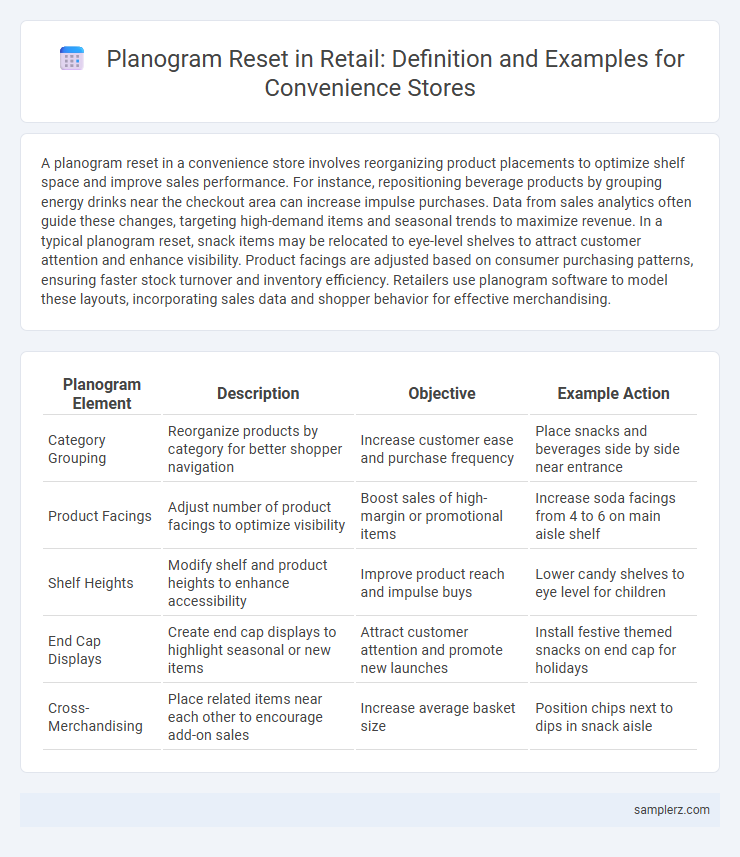A planogram reset in a convenience store involves reorganizing product placements to optimize shelf space and improve sales performance. For instance, repositioning beverage products by grouping energy drinks near the checkout area can increase impulse purchases. Data from sales analytics often guide these changes, targeting high-demand items and seasonal trends to maximize revenue. In a typical planogram reset, snack items may be relocated to eye-level shelves to attract customer attention and enhance visibility. Product facings are adjusted based on consumer purchasing patterns, ensuring faster stock turnover and inventory efficiency. Retailers use planogram software to model these layouts, incorporating sales data and shopper behavior for effective merchandising.
Table of Comparison
| Planogram Element | Description | Objective | Example Action |
|---|---|---|---|
| Category Grouping | Reorganize products by category for better shopper navigation | Increase customer ease and purchase frequency | Place snacks and beverages side by side near entrance |
| Product Facings | Adjust number of product facings to optimize visibility | Boost sales of high-margin or promotional items | Increase soda facings from 4 to 6 on main aisle shelf |
| Shelf Heights | Modify shelf and product heights to enhance accessibility | Improve product reach and impulse buys | Lower candy shelves to eye level for children |
| End Cap Displays | Create end cap displays to highlight seasonal or new items | Attract customer attention and promote new launches | Install festive themed snacks on end cap for holidays |
| Cross-Merchandising | Place related items near each other to encourage add-on sales | Increase average basket size | Position chips next to dips in snack aisle |
Introduction to Planogram Reset in Convenience Stores
Planogram reset in convenience stores involves reorganizing product placement to optimize shelf space, enhance customer experience, and boost sales. This process leverages consumer behavior data and sales analytics to strategically position high-demand and impulse items in prime locations. Effective planogram resets can increase product visibility, reduce out-of-stock situations, and improve overall store profitability.
Key Objectives of a Planogram Reset
A planogram reset in a convenience store aims to optimize product placement to increase sales and improve customer experience. Key objectives include maximizing shelf space efficiency, enhancing product visibility, and aligning inventory with consumer buying patterns. This strategic reorganization helps boost turnover rates and supports inventory management accuracy.
Steps Involved in Executing a Planogram Reset
Executing a planogram reset in a convenience store involves several key steps: first, a thorough analysis of current product performance and store layout is conducted to identify optimization opportunities. Next, a detailed new layout is designed based on consumer buying patterns and category adjacency to enhance product placement and maximize shelf space. Finally, the store team removes existing products, reconfigures shelving according to the planogram, and restocks items, followed by auditing to ensure compliance and identify areas for continuous improvement.
Before-and-After: Visual Examples of Planogram Resets
Planogram resets in convenience stores often involve rearranging key product categories such as snacks, beverages, and impulse buys to maximize shelf space and enhance product visibility. Before the reset, shelves may appear cluttered with inconsistent product placement and poor lighting, while after the reset, merchandise is organized by brand and size, supported by clear signage and strategic eye-level positioning. This transformation typically results in increased sales per square foot and improved customer navigation throughout the store.
Selecting Products and Categories for Reset
Selecting products and categories for a planogram reset in convenience stores involves analyzing sales data and customer buying patterns to identify high-performing and underperforming items. Prioritizing essential categories like beverages, snacks, and tobacco ensures alignment with consumer demand and maximizes shelf space efficiency. Incorporating seasonal products and local preferences further enhances product assortment relevance and drives incremental sales growth.
Tools and Technology for Effective Planogram Reset
Planogram reset in convenience stores leverages digital tools like 3D space planning software and mobile planogram apps to optimize product placement and shelf utilization. Technologies such as electronic shelf labels and real-time inventory tracking systems enhance accuracy and reduce planogram execution time. Integration of AI-driven analytics helps predict customer behavior, ensuring strategic product arrangement that maximizes sales and minimizes stockouts.
Challenges Faced During Planogram Resets
Planogram resets in convenience stores often encounter challenges such as limited shelf space, requiring strategic product placement to maximize visibility and sales. Frequent product turnover and new item introductions complicate inventory management and necessitate staff retraining for accurate shelving. Balancing promotional displays with everyday essentials also demands careful coordination to maintain store flow and customer satisfaction.
Best Practices for Successful Planogram Reset Execution
A successful planogram reset in a convenience store involves detailed analysis of sales data to optimize shelf space for high-demand products and ensure strategic product placement for impulse purchases. Consistent communication and training of store staff on new layouts improve compliance and maintain visual merchandising standards. Regular audits and customer feedback integration help refine the planogram, enhancing shopper experience and driving sales growth.
Measuring Success: KPIs After a Planogram Reset
Measuring success after a planogram reset in a convenience store involves tracking key performance indicators such as sales per square foot, inventory turnover rate, and basket size to evaluate product placement effectiveness. Monitoring customer dwell time and conversion rates reveals how changes influence shopping behavior and purchase frequency. Regular analysis of stockout rates and planogram compliance ensures optimal shelf replenishment and adherence to merchandising standards for sustained growth.
Case Study: Real-Life Example of Planogram Reset in a Convenience Store
A recent planogram reset in a convenience store led to a 15% increase in sales by strategically relocating high-demand snack items to eye-level shelves and repositioning impulse purchase products near the checkout counter. The store utilized shopper behavior data and heat maps to optimize product placement, improving customer navigation and purchase efficiency. This case study highlights the importance of data-driven planogram adjustments to enhance product visibility and boost overall revenue in retail environments.

example of planogram reset in convenience store Infographic
 samplerz.com
samplerz.com